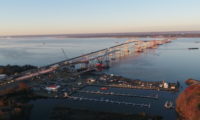The Texas Transportation Commission has approved a plan to fund the $7.5-billion expansion of Interstate 35 through downtown Austin. Although construction is likely several years away, numerous ideas have already been proposed for accommodating the continued spiraling growth of local and through traffic through the state’s capital, while also eliminating what many perceived as a barrier that has long isolated many of the city’s minority neighborhoods.
Spurred in large part by a growing technology industry, metropolitan Austin’s population has soared in recent years to surpass 2 million residents. However, I-35 was last modified in the 1970s with the addition of upper-deck travel lanes in the downtown area. As a result, the highway regularly bogs down with more than 200,000 vehicles a day. Forecasts call for that volume to increase by another 116,000 vehicles over the next 20 years.
At the same time, I-35 and its predecessor highways have preserved the segregation-era separation of East Austin’s largely black and Latino neighborhoods. Some areas along Sixth Street and other major thoroughfares that cross beneath I-35 have seen redevelopment in the form of new residential complexes and entertainment offerings.
Eying a potential five-year construction phase beginning in 2025, Texas Dept. of Transportation plans an extensive public input program to shape a design for the revamped highway. And there is no shortage of ideas.
Concepts for expanding I-35 released last year augmented the existing roadway with non-tolled managed lanes reserved for high-occupancy vehicles. Others, including a recently convened Urban Land Institute panel, have suggested rebuilding the highway underground, and adding caps to create space for parks and other amenities. Such an approach that would likely require additional funding as well as revisions to the interstate’s existing connections to city landmarks such as the University of Texas, the popular Sixth Street entertainment corridor, the Austin Convention Center and downtown business and government offices.
The city is also pursuing a multi-billion transit plan called Project Connect that includes expansion of an existing urban rail system.



Post a comment to this article
Report Abusive Comment